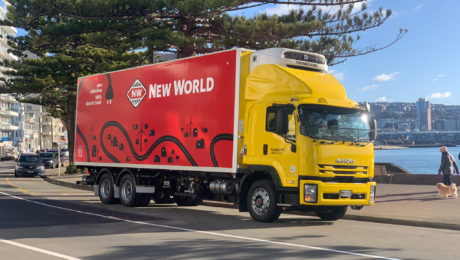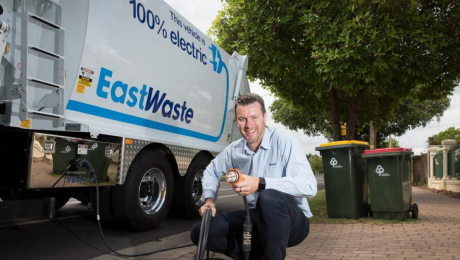Heavy EV keeps things cool and green
Foodstuffs and the Energy Efficiency and Conservation Authority (EECA) have partnered up to build New Zealand’s first electric powered refrigerated heavy duty truck.
From the tailgate to the engine and the fridge-freezer unit that sits on top, everything on the vehicle is powered by a battery.
It is the latest of several projects between Foodstuffs and EECA as they collaborate in the drive towards a carbon neutral New Zealand by 2050.
The full cost of the truck hasn’t been totalled yet, however EECA funded $400,000 towards the project which also included two other ambient trucks with all three now on the road.
It followed Foodstuffs’ successful application to the Low Emission Vehicles Contestable Fund for co-funding support.
Foodstuffs NZ sustainability manager Mike Sammons says it’s “a huge feat of Kiwi ingenuity”.
“We couldn’t purchase a fully electric refrigerated truck, because it didn’t exist, so we had the idea to custom build one,” he says.
With carbon emissions from transport currently at 18% in New Zealand, Sammons is optimistic this new innovation will have a role to play in transport carbon reduction.
“We’re 100% committed to playing our part in creating more sustainable transport solutions, building a fully electric refrigeration truck is a massive leap towards a carbon-free future for New Zealand,” he says.
Sammons says data on the truck will be collected over the next 12 months “to really get an understanding of the potential for electric trucks as a viable alternative to the status quo”.
EECA transport portfolio manager Richard Briggs says they could see the potential immediately.
“Heavy vehicles make up less than 5% of the national fleet, but are responsible for 29% of land transport emissions, so decarbonising the heavy fleet as much as possible will have a huge, positive impact.”
EECA had previously co-funded Foodstuffs to deliver 61 fast charge stations and 28 electric delivery vans.
“Foodstuffs has developed a great track record in this space, proving the viability of electrification,” Briggs says.
With EECA’s backing, Foodstuffs pulled together some of the country’s brightest and best transport, electrical and refrigeration engineers to convert the standard Isuzu FVY, 24 tonne, 6-wheel diesel truck to be 100% electric powered.
The electric truck will operate from the Foodstuffs distribution centre in Grenada, Wellington, under the stewardship of Foodstuffs North Island Transport.
Fleet and safety manager Blair Inglis played a big role in driving the project forward.
“We knew from the start building a fully electric EV truck would be a challenge and we had our fair share of them along the way, including COVID-19, but we always knew if we could pull it off, this innovation could set the direction for the future of commercial transport in New Zealand and that’s very exciting,” Inglis says.
After extensive testing and driver training, the electric truck recently set out on its first official delivery run to New World Miramar, a 60 km round trip.
With a range of between 150 and 200km and capable of transporting 14 pallets of product at temperatures as low as minus 15 degrees centigrade, the truck completed its inaugural journey with ease.
Foodstuffs North Island Transport driver Bagish Bansal gave the truck its first official run and says he “really liked it”.
“The ride was smooth, it was really quiet in the cab and it’s great to know that you’re helping the environment while doing your job, that feels really good. I really hope this is the shape of things to come for my occupation,” Bansal says.
Automotive technology company SEA Electric carried out the EV conversion on the Isuzu truck featuring its SEA-Drive 180 power system.
SEA Electric NZ general manager Stephen Fairweather says it’s the first heavy refrigerated truck that’s hit the road, however a smaller EV refrigerated truck for Countdown home delivery was the first project.
He says the company has been involved in a number of EV projects from waste collection, home delivery, daily freight and elevated work platform trucks.
“This vehicle’s requirements is certainly the largest refrigeration unit we’ve tackled in New Zealand, although it has been done prior in Australia. With the correct auxiliary equipment it is manageable,” Fairweather says.
“SEA Electric’s drive system is ideally suited to the metropolitan delivery model where this type of requirement comes into play. Being able to configure the SEA Drive system to customers usage, GVM and range requirements enables endless possibilities,” he says.
The company also worked closely with transport refrigeration specialist Thermo King and Fairweather says alignment between both parties is “critical” to getting the job done.
Earlier this year, New Zealand fishing company Sanford also unveiled an all-electric chilled van as part of its Auckland deliveries.
READ MORE, Article appeared in the July Issue of TransportTalk, by Nigel Moffiet, July 21 2020
- Published in Articles, E-Range, Media Release, Mobile, Networking, News, SEA-Drive, Technology
SA’s First Electric Garbage Truck Doing The Rounds
What’s said to be South Australia’s first zero-emissions electric-powered kerbside garbage and recycling collection truck went into service in Adelaide last week.
The truck was supplied by Queensland-headquartered Superior Pak and uses drivetrain technology from Victoria’s SEA Electric, which is enjoying significant success with its commercial EV solutions both locally and overseas.
Zero emissions are great, but this truck is also expected to save East Waste a chunk of change.
“It is much more than a terrific environmental initiative by East Waste,” said General Manager Rob Gregory . “It will deliver financial gain to better manage the cost of kerbside collections of recyclable resources and waste.”
Valued at approximately $550,000, the EV cost $150,000 more than a diesel truck, but East Waste has conservatively projected it will save more than $220,000 over its seven year life compared to a diesel truck – so net savings of $70,000 or $10,000 a year. This is due in part to the difference in “fuel” costs, and maintenance costs reduced by at least two-thirds. East Waste points out the savings could be higher if the cost of diesel goes up and the truck lasts more than seven years, which is expected.
What’s Charging It?
Electricity used for recharging the truck is being offset by a 36kW solar power system at East Waste’s Ottaway depot. Details weren’t provided on how much energy the truck will consume over a typical day or whether the solar panels will generate equivalent to its requirements, but the solar system should crank out somewhere in the region of 56.8 megawatt-hours of electricity annually.
Even if the solar panels don’t cover all its energy use (and my guess is they won’t, making the zero emissions claim debatable), South Australia’s electricity supply is becoming increasingly cleaner – more than half of the state’s generation is from wind and solar energy.
Emissions reduction and financial savings aside, another advantage of using electric trucks for rubbish and recycling runs is they are much quieter. This means you’ll be able to hear the emptying of the neighbour’s recycling bin full of empty stubbies more clearly.
East Waste is a subsidiary of seven metropolitan Adelaide councils: the cities of Burnside, Campbelltown, Mitcham, Norwood, Payneham & St Peters and Prospect, the Town of Walkerville and Adelaide Hills Council.
Other Electric Waste Collection Trucks In Australia
Among other electric rubbish trucks in use across the country are Cleanaway’s “EVie” vehicles and a tipper truck used for hard rubbish collection by Victoria’s Yarra City Council.
Another electric recycling truck featuring SEA electric drivetrain technology, this one for SUEZ in Western Australia, has a 230kWh battery providing more than 200 kilometre driving range before recharge – but there’s lots of stopping and starting with this sort of activity. SEA Electric says it will be capable of 1,200 bin lifts a day.
SolarQuotes Blog, February 25,2020 by Michael Bloch
- Published in Articles, E-Range, Media Release, Mobile, Networking, News, SEA-Drive, Technology
- 1
- 2



